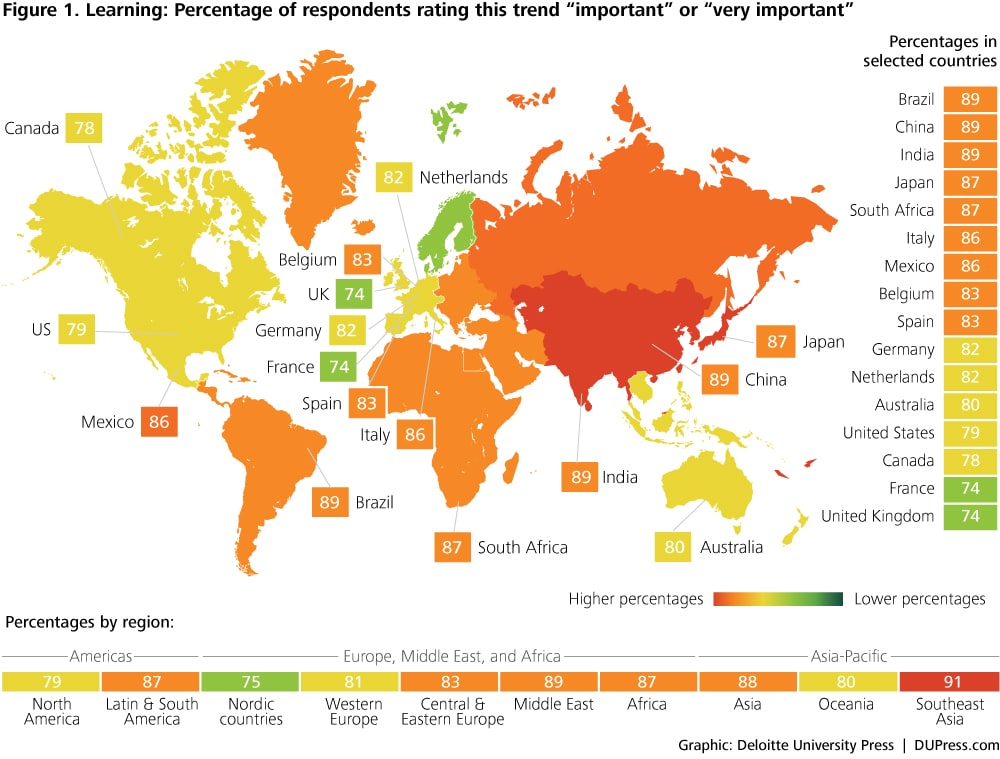Learning has been saved

Learning Employees take charge
Corporate learning departments are changing from education providers to content curators and experience facilitators, developing innovative platforms that turn employee learning and development into a self-driven pursuit.
View the complete Global Human Capital Trends 2016 report
Explore
View 2016 Global Human Capital Trends
Create and download a custom PDF
Watch the related video
Explore the related infographic
The pressure on organizations to improve learning and development continues to intensify. Advances in technology, shifts in demographics, and the constant competitive necessity to upgrade workforce skills are disrupting corporate learning. These forces are pushing companies to develop new ways to put employees in charge of the learning experience and foster a culture of learning throughout the organization. This year, the big change is a shift beyond internal programs aimed at developing people to innovative platforms that enable people to develop themselves.
- More than eight in ten executives (84 percent) in this year’s survey view learning as an important (40 percent) or very important (44 percent) issue.
- Employees at all levels expect dynamic, self-directed, continuous learning opportunities from their employers.
- Despite the strong shift toward employee-centric learning, many learning and development organizations are still struggling with internally focused and outdated platforms and static learning approaches.
Learning continues to be important to HR and business executives worldwide as they strive to adapt to the disruptive change that is sweeping through corporate learning and development organizations. (See figure 1 for our survey respondents’ ratings of learning’s importance across global regions and selected countries.) Several factors are driving the demand for change that has accelerated to warp speed over the past year.
First, nearly every CEO and CHRO reports that their companies are not developing skills fast enough or leaders deeply enough.1 In today’s highly competitive global economy and intensely competitive talent market, the C-suite clearly understands that companies that do not constantly upgrade skills and rapidly build leaders will not be able to execute their business plans. In today’s business environment, learning is an essential tool for engaging employees, attracting and retaining top talent, and developing long-term leadership for the company.
The transformation of learning is a powerful story, and most organizations are still in the first or second act of this multi-act drama.
Second, the ubiquity of always-connected mobile devices makes learning potentially available everywhere and accessible to everyone at any time. Employees can now take a course on nearly any subject online, search for an expert video or podcast to learn a quickly needed skill, and even earn a college degree in a new topic like data science without leaving their desk—or a couch or coffee shop. This new world of consumer-centric learning puts employees, not L&D departments, in charge.
 Third, employees at all levels now recognize that “the learning curve is the earning curve,”2 and they are demanding access to dynamic learning opportunities that fit their individual needs and schedules.3 Millennials and other young employees have grown up in this self-directed learning environment. They expect it as part of their working lives and careers—and they will move elsewhere if employers fail to provide it. Already, 30 percent of executives in our survey see learning as the primary driver of employee development.
Third, employees at all levels now recognize that “the learning curve is the earning curve,”2 and they are demanding access to dynamic learning opportunities that fit their individual needs and schedules.3 Millennials and other young employees have grown up in this self-directed learning environment. They expect it as part of their working lives and careers—and they will move elsewhere if employers fail to provide it. Already, 30 percent of executives in our survey see learning as the primary driver of employee development.
While many organizations are struggling to adapt to these challenges, high-performing companies are seizing the opportunity to promote a new culture of learning, upending traditional models and transforming how employees learn. These organizations are adopting new mind-sets, fundamentally rethinking what “learning” and “development” mean in the context of their business. They place the employee at the center of a new architecture and new vision that treats learning as a continuous process, not an episodic event, and as a company-wide responsibility, not one confined to HR (figure 2).4
Supporting this new vision, learning and development organizations at these innovative companies are adopting new and expanded learning architectures.5 They see their role as not simply to push out content they have developed, but to enable employees to access content from a wide range of internal and external sources to create individual learning programs. To facilitate the effort to help employees “learn how to learn,” L&D teams are building internal knowledge-sharing programs, developing easy-to-use portals and video sharing systems, and promoting collaborative experiences at work that help people constantly learn and share knowledge.
These efforts seek to leverage the profound shifts taking place in the learning industry. Traditional learning management system companies are rapidly evolving in their ability to deliver modern, compelling experiences for learners. Now, a new breed of disruptive, platforms is starting to arrive. New money and ideas are pouring into this sector. CB Insights, which tracks venture investments, estimates that more than $3 billion was invested in new learning and educational start-ups in the first six months of 2015. Almost $1 billion of this went into tools, content, and companies that focus on the corporate market.6
Much of this investment is directed at tools to harness video, new mobile learning apps, and an explosion of content marketplaces. Today, any employee can browse through content from Coursera, Udemy, Udacity, or a dozen other providers and instantly access a lecture, course, or workshop on a needed skill. Such platforms offer learning opportunities at little or no cost and even allow employees to interact online with experts in the field—learning exactly what they need, when they need it, at a time that fits their schedules.
This kind of technologically enabled, on-demand learning experience rarely exists within a corporation, and it is a world away from the traditional learning programs still used by most L&D organizations. In particular, many companies are still struggling to ride the wave and integrate external platforms as part of their employee learning. In our survey, respondents cited a wide range of external learning opportunities that could impact internal development, including external certificates (32 percent), MOOCs (18 percent), and external, self-directed learning powered by social media (14 percent). Still, despite this robust array of choices, 61 percent of executives report challenges in moving their organizations toward external self-directed learning.
The goal is no longer to craft a learning program but to move beyond programs to curate the learning experience. Corporate training departments must become “learning experience architects” (to use a term from design thinking), building a compelling and dynamic experience for employees and helping employees learn how to learn.
Employees need to be viewed as customers to be satisfied, rather than as students to be pressured into traditional learning classrooms.
Figure 3 describes some characteristics of this new mind-set and the ways in which it could reshape the role of L&D organizations that embrace it. Of these shifts, the most fundamental for HR to make is to think of learning from the perspective of a user’s daily experiences and career aspirations, rather than as a series of processes and programs that the learning function wants to roll out. The chief learning officer has the opportunity to lead the charge to make L&D professionals more like product managers working for customers who have unfulfilled needs, rather than simply designers of courses that employees are required to complete.
Figure 3. Learning, today and tomorrow
| Today | Tomorrow |
| Learning is a series of corporate programs built around L&D-designed content and L&D-approved experts. | Learning is an “environment” and an “experience,” leveraging experts, content, and materials sourced and recommended by external communities as well as by other employees and internal experts (not just L&D). |
| The learning environment is managed by a corporate learning management system—essentially a large catalog filled with courses. | The learning environment feels like a consumer website that provides videos, courses, content, and access to experts—as well as recommendation engines that help people find precisely what they need. |
| L&D, business, and compliance experts push out training, identifying required courses to be completed by employees based on roles. | Employees pull learning, navigating and accessing opportunities from inside and outside of the company. |
| The focus is on internal training sanctioned by the company. | External training is available from any digital content source. |
| Learning professionals are generalists who do everything from design to development, logistics, and measurement. | Learning professionals are specialists who are excellent at the component they own. |
| Training follows a lecture-based model guided by an expert. | Training is experiential, relying on simulations, case studies, and flipped classrooms. |
| Employees learn specific skills through expert-guided instruction. | Employees learn how to learn through facilitation and coaching. |
| Organizations create detailed, exhaustive, skills-based competencies that drive the learning agenda. | Organizations create high-level frameworks that outline broad capabilities. |
| The learning organization plays a lead role in what a person learns and focuses on delivering work experiences, interactions with others, and formal training in the traditional 70-20-10 ratio. | The learning organization plays a supporting role in what a person learns, expanding the 10 to include “inside” and “outside” learning; shifting the 20 to include internal and external networks; and redefining the 70 to include corporate, community, and social experiences. |
The transformation of learning is a powerful story, and most organizations are still in the first or second act of this multi-act drama. But the trend is clear: The learning organization must help learners figure out how to obtain the learning they need for themselves, from both inside and outside the company. If your organization has not yet embarked on this journey, the time to start is now.
Lessons from the front lines
MasterCard has been on a journey, transforming itself from a traditional payments processing company into a technology company that provides the infrastructure that connects consumers, banks, and businesses.7 With its underlying business model evolving to address new opportunities and competitive threats, the company is seeking to build capabilities to stay agile and keep new products and services flowing. And with an increasingly diverse workforce—now more than 40 percent Gen Y—it is becoming harder to engage employees with traditional learning approaches.
Janice Burns, chief learning officer and head of Global Talent Development and Organizational Effectiveness, challenged her team to reinvent their approach to learning by constructing responsive, agile, and personal solutions that would meet the organization’s evolving demands along with employees’. To do that, she first had to lead a mind-set shift within her own organization—away from periodic programs owned by learning professionals to self-directed solutions owned by individual employees. No longer would her learning team focus on telling people what to learn but instead show them what they can learn, providing access to resources, tools, and connections to enable individuals to do their jobs and build their careers better.
Key to refocusing her team on the individual was segmenting audiences and getting to know their needs, which she did by aligning Global Talent Development (GTD) leaders with specific business units to work with operational leaders. She also empowered her team to experiment with new learning tools and technologies, encouraging them to work lean, fail fast, and scale up successes. Trying something that did not work became acceptable—in some ways a sign of tangible progress toward a culture of innovation.
As they explored new learning formats, the GTD team’s attention shifted from traditional courses and programs pushed to employees solely via the learning management system (less important in any high-performing learning organization), to more employee-driven solutions such as mobile performance support, massive open online courses (MOOCs), on-demand micro-learning, and online communities.
One new learning platform taking off with MasterCard’s Operations & Technology (O&T) group, for example, is Degreed. The system, which enables self-serve career development, empowers individuals and subject matter specialists to curate their own learning “playlists,” mixing and matching internal and external learning content from a variety of sources and formats. Articles, videos, MOOCs, podcasts, and webinars can all be woven together into a personalized learning experience to help employees develop the skills they want to focus on.
The initial feedback from the roll-out to the company’s O&T function is promising. Stories highlight that managers and professionals now feel equipped with tools to drive their own development. “I am willing to invest more into the tool because it will follow me no matter where my career takes me,” said one systems analyst. Similar feedback will continue to emerge as MasterCard deploys the platform more broadly across the rest of the enterprise.
MasterCard is in the early stages of its journey toward a culture of entrepreneurship and empowerment. However, having the GTD organization act as a living example of this new culture through its own experimental approach has already enabled it to become a meaningful catalyst for change within MasterCard.
Where companies can start
- Recognize that employee-learners are in the driver’s seat: Learning organizations should think deeply about how the user experiences a company’s learning offerings. Employees need to be viewed as customers to be satisfied, rather than as students to be pressured into traditional learning classrooms.
- Become comfortable with the shift from push to pull: Switching from a content-centric “push” approach to a learner-centric “pull” approach requires a cultural shift within learning organizations. Giving up full control over learning content, schedules, and platforms may not be easy, but learning organizations that embrace this shift can deliver more effective learning throughout the organization.
- Use design thinking: Learning organizations should think less about developing content and more about the month-by-month, day-by-day, and hour-by-hour experience of the learner.
- Use technology to drive employee-centric learning: Mobile, social, and web-based platforms that can deliver on-demand learning content are “must-have” capabilities. The best systems can easily integrate any type of digital content and allow learners, as well as learning professionals and business managers, to add and suggest content. Companies should be cautious before investing in massive new systems, and they should monitor developments from innovative vendors to help build effective learning applications.
- Realign and reengage: HR and learning leaders must align the learning function with business needs and goals. For many learning teams, doing so can also be an opportunity to reengage with employees, as many learners have stopped looking to their corporate learning departments for training and are already immersed in the enormous range of available digital learning and content.
- Adopt a learning architecture that supports an expanded vision for development: Rethink what “development” means in the context of the organization. If such a vision does not yet exist, adopt one and communicate it broadly.
- Adopt a learning architecture that supports continuous learning: Dedicate resources, set expectations, and align corporate culture with the goal of enabling employees to get the learning they need, when they need it, at every stage in their careers.
Bottom line
Shifting from an internally focused, corporate-centric learning universe to a learner-centric one upends many long-held beliefs in the HR community. Employees will likely find it easier to make this pivot than HR departments because this new world is already part of their mobile, social, and online lives. For their part, business, learning, and HR leaders must embrace a new mind-set that puts learners in the driver’s seat, redesigning programs to harness the power of technology and the amazingly diverse wealth of instantly available external content, and offering great user experiences to learners.
Deloitte’s Human Capital professionals leverage research, analytics, and industry insights to help design and execute the HR, talent, leadership, organization, and change programs that enable business performance through people performance. Visit the “Human Capital” area of www.deloitte.com to learn more.
© 2021. See Terms of Use for more information.








